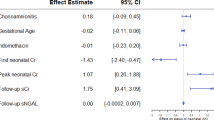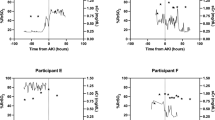Abstract
Objective:
The Aim of this study was to investigate maternal and neonatal factors associated with serum creatinine (SeCr) changes in a representative cohort of preterm newborns during their first week of life.
Study Design:
Retrospective study. All the infants born less than 32 weeks of gestational age (GA) and cared for in our neonatal intensive care unit between January 2001 and December 2005 were eligible for the analysis. Epidemiological data of all mother–infant pairs and neonatal SeCr values were recorded.
Result:
A total of 652 infants were studied. Multivariate regression analysis showed that the main independent factors associated with high SeCr at day 1 were hypertensive disease of pregnancy (P<0.0001) and advancing hour of life (P<0.0001), with minimal contribution of placental abruption (P<0.05) and higher GA (P<0.05). Lower GA (P<0.0001) and ibuprofen-treated patent ductus arteriosus (PDA; P<0.0001) were the main analyzed factors independently associated with higher SeCr peak (defined as the highest SeCr during the week), with less contribution of respiratory distress syndrome (P<0.01) and early onset infection (P<0.05). In infants with hemodynamically significant PDA (hsPDA) SeCr before ibuprofen administration was higher when compared to GA-matched controls without hsPDA (P< 0.0001).
Conclusion:
SeCr peak was inversely correlated to GA in preterm infants born less than 32 weeks of GA. Neonatal rather than maternal morbidity affected SeCr peak. In hsPDA, SeCr increase preceded ibuprofen administration.
This is a preview of subscription content, access via your institution
Access options
Subscribe to this journal
Receive 12 print issues and online access
$259.00 per year
only $21.58 per issue
Buy this article
- Purchase on Springer Link
- Instant access to full article PDF
Prices may be subject to local taxes which are calculated during checkout

Similar content being viewed by others
References
Gordjani N, Burghard R, Leititis JU, Brandis M . Serum creatinine and creatinine clearance in healthy neonates and prematures during the first days of life. Eur J Pediatr 1998; 148: 143–145.
Wilkins BH . Renal function in sick very low birth weight infants: 1. Glomerular filtration rate. Arch Dis Child 1992; 67: 1140–1145.
Lao TT, Loong EP, Chin RK, Lam YM . Renal function in the newborn. Newborn creatinine related to birth weight, maturity and maternal creatinine. Gynecol Obstet Invest 1989; 28 (2): 70–72.
Manalich R, Reyes L, Herrera M, Melendi C, Fundora I . Relationship between weight at birth and the number and size of renal glomeruli in humans: a histomorphometric study. Kidney Int 2000; 58 (2): 770–773.
Gallini F, Maggio L, Romagnoli C, Marrocco G, Tortorolo G . Progression of renal function in preterm neonates with gestational age ⩽32 weeks. Pediatr Nephrol 2000; 15: 119–124.
Auron A, Mhanna MJ . Serum creatinine in very low birth weight infants during their first days of life. J Perinatol 2006; 26: 755–760.
Guignard JP, Drukker A . Why do newborn infants have a high plasma creatinine? Pediatrics 1999; 103 (4): e49.
Miall LS, Henderson MJ, Turner AJ, Brownlee KG, Brocklebanck JT, Newell SJ et al. Plasma creatinine rises dramatically in the first 48 h of life in preterm infants. Pediatrics 1999; 104 (6): 1–4.
Toth-Hayn P, Drukker A, Guignard JP . The stressed neonatal kidney: from pathophysiology to clinical management of neonatal vasomotor nephropathy. Pediatr Nephrol 2000; 14 (3): 227–239.
Ohlsson A, Walia R, Shah S . Ibuprofen for the treatment of patent ductus arteriosus in preterm and/or low birth weight infants. Cochrane Database Syst Rev 2008; 23 (1): CD003481.
Cornet B, Gouyon JB, Binquet C, Sagot P, Ferdynus C, Métral P et al. Using discharge abstracts as a tool to assess a regional perinatal network. Rev Epidemiol Sante Publique 2001; 49 (6): 583–593.
Quantin C, Allaert FA, Gouyon B, Cohen O . Proposal for the creation of a European healthcare identifier. Stud Health Technol Inform 2005; 116: 949–954.
Iyer P, Evans N . Re-evaluation of the left atrial to aortic root ratio as a marker of patent ductus arteriosus. Arch Dis Child 1994; 70: 112–117.
Kluckow M, Evan N . Early echocardiographic prediction of symptomatic patent ductus arteriosus in preterm infants undergoing mechanical ventilation. J Pediatr 1995; 127: 774–779.
Lorenz JM . Assessing fluid and electrolyte status in the newborn. National Academy of Clinical Biochemistry. Clin Chem 1997; 43 (1): 205–210.
Choker G, Gouyon JB . Diagnosis of acute renal failure in very preterm infants. Biol Neonate 2004; 86 (3): 212–216.
Cuzzolin L, Fanos V, Pinna B, di Marzio M, Perin M, Tramontozzi P et al. Postnatal renal function in preterm newborns: a role of diseases, drugs and therapeutic interventions. Pediatr Nephrol 2006; 21: 931–938.
Bueva A, Guignard JP . Renal function in preterm neonates. Pediatr Res 1994; 36: 572–577.
Sonntag J, Prankel B, Waltz S . Serum creatinine concentration, urinary creatinine excretion and creatinine clearance during the first 9 weeks in preterm infants with a birth weight below 1500 g. Eur J Pediatr 1996; 155 (9): 815–819.
Manzke H, Spreter von Kreudenstein P, Dorner K, Kruse K . Quantitative measurements of the urinary excretion of creatinine, uric acid, hypoxanthine and xanthine, uracil, cyclic AMP, and cyclic GMP in healthy newborn infants. Eur J Pediatr 1980; 133: 157–161.
Thayyil S, Sheik S, Kempley ST, Sinha A . A gestation- and postnatal age-based reference chart for assessing renal function in extremely premature infants. J Perinatol 2008; 28: 226–229.
Gouyon JB, Guignard JP . Management of acute renal failure in newborns. Pediatr Nephrol 2000; 14: 1037–1044.
Giniger RP, Buffat C, Millet V, Simeoni U . Renal effects of ibuprofen for the treatment of patent ductus arteriosus in premature infants. J Matern Fetal Neonatal Med 2007; 20 (4): 275–283.
Allegaert K, Vanhole C, de Hoon J, Guignard JP, Tibboel D, Devlieger H et al. Nonselective cyclo-oxygenase inhibitors and glomerular filtration rate in preterm neonates. Pediatr Nephrol 2005; 20 (11): 1557–1561.
Allegaert K, Rayyan M, Anderson BJ . Impact of ibuprofen administration on renal drug clearance in the first weeks of life. Methods Find Exp Clin Pharmacol 2006; 28 (8): 519–522.
Vanpée M, Ergander U, Herin P, Aperia A . Renal function in sick, very low birth weight infants. Acta Paediatr 1993; 82 (10): 714–718.
Shimada S, Kasai T, Konishi M, Fujiwara T . Effects of patent ductus arteriosus on left ventricular output and organ blood flows in preterm infants with respiratory distress syndrome treated with surfactant. J Pediatr 1994; 125 (2): 270–277.
Shimada S, Kasai T, Hoshi A, Murata A, Chida S . Cardiocirculatory effects of patent ductus arteriosus in extremely low-birth-weight infants with respiratory distress syndrome. Pediatr Int 2003; 45 (3): 255–262.
Author information
Authors and Affiliations
Corresponding author
Rights and permissions
About this article
Cite this article
Iacobelli, S., Bonsante, F., Ferdinus, C. et al. Factors affecting postnatal changes in serum creatinine in preterm infants with gestational age <32 weeks. J Perinatol 29, 232–236 (2009). https://doi.org/10.1038/jp.2008.203
Received:
Revised:
Accepted:
Published:
Issue Date:
DOI: https://doi.org/10.1038/jp.2008.203
Keywords
This article is cited by
-
When the progresses in neonatology lead to severe congenital nephron deficit: is there a pilot in the NICU?
Pediatric Nephrology (2022)
-
Accuracy of diagnosing acute kidney injury by assessing urine output within the first week of life in extremely preterm infants
Clinical and Experimental Nephrology (2022)
-
Maturation of glomerular filtration rate in neonates and infants: an overview
Pediatric Nephrology (2021)
-
Renal function in small for gestational age preterm infants
Journal of Perinatology (2019)
-
Patent ductus arteriosus is associated with acute kidney injury in the preterm infant
Pediatric Nephrology (2019)



